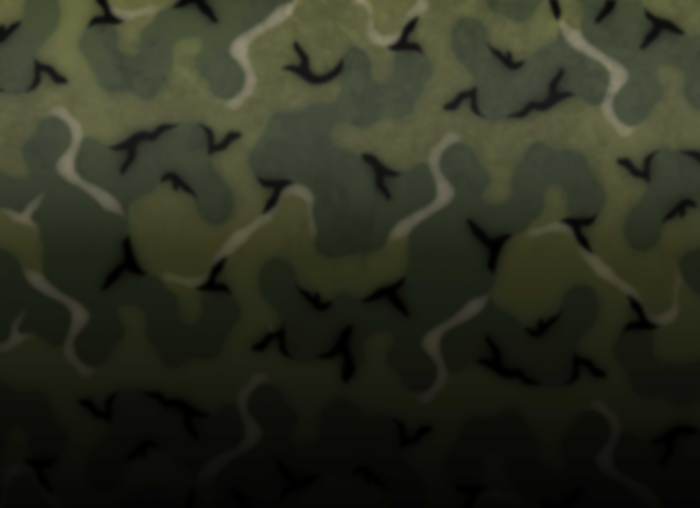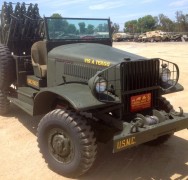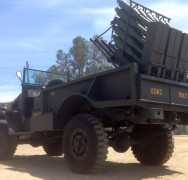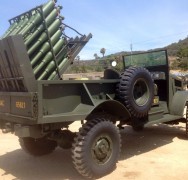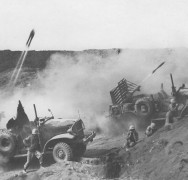International M-2-4 Rocket Truck
The Marines formed an Experimental Rocket Unit in June 1943 and first deployed rail-launched barrage rockets during the fighting in the upper Solomons. There the heavily canopied jungles limited their effectiveness. Once mounted on trucks and deployed to the Central Pacific, however, the weapons proved much more useful, particularly during the battle of Saipan. The Marines modified the small trucks by reinforcing the tail gate to serve as a blast shield, installing a hydraulic jack to raise and lower the launchers, and applying gravity quadrants and elevation safety chains. Crude steel rods welded to the bumper and dashboard helped the driver align the vehicle with aiming stakes.
The Marines saw lightweight, vehicle-mounted rocket launchers as artillery support that could be brought into action quickly when assaulting enemy-held beaches. Their training school for rocketeers, established on the Hawaiian island of Oahu early in 1944, graduated its first class in April of that year. The first of six “provisional rocket detachments” was formed the same week. Each detachment consisted on one officer, fifty-seven enlisted men, and (initially) a dozen 1-ton trucks with 1-ton trailers. All six rocket detachments eventually saw action in the Pacific, first at the invasion of Saipan in June 1944 and later in the invasion of the Philippines in late 1944 and the invasions of Iwo Jima and Okinawa in 1945.
Although frontline Marines appreciated the support of the 1st and 2d Provisional Rocket Companies’ truck-mounted 4.5-inch rocket launchers, they always dreaded the period immediately following a barrage. The dust and smoke thrown up at that time served as a perfect aiming point for enemy artillery and mortars which soon followed.
Iwo’s Fire Brigades: The Rocket Detachments
Attached to the assault divisions of the landing force at Iwo Jima were provisional rocket detachments. The infantry had a love-hate relationship with the forward-deploying little rocket trucks and their plucky crews. The “system” was an International one-ton 4×4 truck modified to carry three box-shaped launchers, each containing a dozen 4.5-inch rockets. A good crew could launch a “ripple” of 36 rockets within a matter of seconds, providing a blanket of high explosives on the target. This the infantry loved—but each launching always drew heavy return fire from the Japanese who feared the “automatic artillery.”
Treeless, hilly Iwo Jima proved an ideal battleground for these so-called “Buck Rogers Men.” At Iwo, the 1st Provisional Rocket Detachment supported the 4th Marine Division and the 3d Detachment supported the 5th Division throughout the operation (the 3d Division did not have such a unit in this battle). Between them, the two detachments fired more than 30,000 rockets in support of the landing force.
The 3d Detachment landed over Red Beach on D-day, losing one vehicle to the surf, others to the loose sand or heavy enemy fire. One vehicle reached its firing position intact and launched a salvo of rockets against Japanese fortifications along the slopes of Suribachi, detonating an enemy ammunition dump. The detachment subsequently supported the 1st Battalion, 28th Marines’ advance to the summit, often launching single rockets to clear suspected enemy positions along the route.
As the fighting moved north, the short range, steep angle of fire, and saturation effect of the rocket launchers kept them in high demand. They were particularly valuable in defilade-to-defilade bombardments marking the final punctuation of pre-assault prep fires. But their distinctive flash and telltale blast also caught the attention of Japanese artillery spotters. The rocket trucks rarely remained in one place long enough to fire more than two salvos. “Speedy displacement” was the key to their survival. The nearby infantry knew better than to stand around and wave goodbye; this was the time to seek deep shelter from the counterbattery fire sure to follow.
